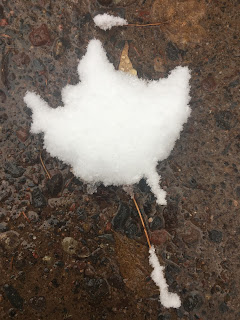I stand atop a rickety footbridge, under which swiftly flows from the Canadian Rockies into its eastern foothills a cold and shallow but fairly wide stream, the Ghost River, northwest of Calgary. I have come to help lead a contemplative retreat for pastors who are in seasons of change or discernment, seeking direction and renewed vision from God. One cannot lead these kinds of retreats without also being moved to do much personal reflection and contemplation of their own. At least that is always true for me.
The Ghost, at least in the fall season, runs through a fairly wide and open valley. The rocky streambed is easily four or more times the size of this late September flow. It must be quite a spectacle in the fury of spring runoff. But for now the river is completely contained beneath a small bridge, which may be moved into place on wheels over wherever the stream has finally chosen to make its path that particular summer. Crystal clear and certainly no more than a couple feet at its deepest, it runs swiftly, yet, because of the lack of large boulders, also quite smoothly, allowing the stream bottom to be almost plainly seen. It makes me feel I am soaring over the water, or even walking on it.
Facing upstream, quickly on the flow comes. Then turning easily and facing downstream, quickly away the flow goes. I cannot help but think about the passage of time, coming and going, allegorically called to mind. Having done a pretty good job convincing myself that a person in his 60’s is not old, I cannot for the life of me convince myself the same as the next decade looms, now not far away.
What seems to be flowing toward me as I face upriver? Aging, obviously, and what always seems the very speedy passage of time. Physical limitations will be coming on; that’s what older bodies do, something my doctor has been telling me since my thirties! Then there’s change, personal and corporate, local and global, always flowing toward me in one way or another. Cultural changes also come on steadily, some that delight me, others that surprise me, and a few that just plain make me mournfully sad. Unknown new relationships are coming my way. Yes, there are even new ministry opportunities that may flow to me that I cannot yet conceive. Heck, even death is certainly getting nearer, though hopefully not imminent, as unstoppable as the Ghost River. Of course, then, my heavenly reward is also nearing, though I confess I don’t think much about heaven, content with the fullness of life God gives me now and the ongoing mission God has called me to. And finally, my ultimate legacy flows toward me, where everything I have labored toward will be behind me, all of it tested for ultimate value; whether it will show itself as ‘silver, gold and precious stones, or wood, hay and stubble’ (see 1 Corinthians 3:11-12) remains to be known.
These are the things that flow toward me.
Turning around, what seems to be flowing away from me? Certainly ministry as I have heretofore known it these near fifty years. Similar to above, time always drifts downstream, along with my virility. Definitely. In some ways, my progeny seem to be rushing away, as well they all should, on into their own lives and futures. Thankfully, some of the the ‘wood, hay and stubble’ of my lifelong labors I can already see fading in the distance, some of them things I thought so important at the time. And then there’s culture again; it seems also not only to be rushing toward me but moving away, as I have a more difficult time keeping up with it all. And lastly, of course, old dear ones are flowing away, passing, people whom I have loved profoundly; yet by faith they are also in my future, me flowing strangely toward them.
Still, no matter what is flowing toward me or away, coming or going, I find myself in a settled place. Perhaps this particular Ghost is Holy.
An old hymn text occurs to me…
Like a river glorious is God’s perfect peace,
Over all victorious in its bright increase:
Perfect, yet it floweth fuller every day;
Perfect, yet it growth deeper all the way.
Stayed upon Jehovah, hearts are fully blessed,
Finding, as He promised, perfect peace and rest.
~~ RGM, September 29 2022
































